Activities
Find out more about how singing can support health and wellbeing through our books.
Summarising recent research, our practical, down-to-earth advice has the potential to transform your mind, your body, your life.
Summarising recent research, our practical, down-to-earth advice has the potential to transform your mind, your body, your life.
“Your voice is the fingerprint of your soul.”

— Anonymous
New Release
Unleash the Healing Power of Singing
Download today to start your journey on a “bold path to stress relief and inner strength”.

“When we sing, we pray twice.”

— Saint Augustine
6th Century Archbishop of Canterbury
Complete Series Of
Singing Activities
Hover over the card for instructions on how to use the activity or go to the Activities How-To page.

How to Practice Diaphragmatic Breathing:
1. Sit or stand with a straight back. Place one hand on your chest and the other on your abdomen.
2. Inhale deeply through your nose, allowing your abdomen to expand while keeping your chest relatively still.
3. Exhale slowly through your mouth, feeling your abdomen contract as you release the breath.
4. Repeat this cycle 5–10 times, focusing on smooth, controlled breathing.

How to Practice Box Breathing:
1. Inhale slowly through your nose for a count of four.
2. Hold your breath for a count of four.
3. Exhale slowly through your mouth for a count of four.
4. Hold your breath again for a count of four.
5. Repeat this cycle four to five times.

How to Practice Alternate Nostril Breathing:
1. Sit comfortably and close your right nostril with your right thumb.
2. Inhale deeply through your left nostril.
3. Close your left nostril with your ring finger and release your thumb from your right nostril.
4. Exhale through your right nostril.
5. Inhale through your right nostril, then close it and exhale through your left.
6. Repeat this cycle for 1–2 minutes, focusing on balanced, steady breaths.

How to Practice Humming:
1. Begin with a comfortable, closed-mouth hum, focusing on keeping your throat relaxed.
2. Experiment with gentle, slow scales or hum along to a simple tune.
3. Pay attention to the vibrations in your face and chest, letting them relax you.

How to Practice Lip Trills:
1. Take a deep breath, then gently press your lips together.
2. Exhale with a light buzzing sound, allowing your lips to vibrate as the air flows out.
3. Practice ascending and descending pitches, focusing on consistent breath flow and relaxed lips.

How to Practice Sirens:
1. Begin with a low note and smoothly glide up to your highest comfortable pitch.
2. Once you reach the top, slide back down to the starting pitch.
3. Repeat this cycle several times, focusing on a smooth, controlled transition between pitches.

How to Practice Progressive Muscle Relaxation:
1. Sit or lie down comfortably and take a few deep breaths.
2. Starting with your feet, tense the muscles for a few seconds, then release.
3. Gradually work your way up through each muscle group (legs, abdomen, chest, shoulders, neck, and face), tensing and relaxing as you go.
4. Focus on the sensation of release and relaxation in each area.

How to Practice Visualisation:
1. Close your eyes and take a few deep breaths.
2. Visualise yourself in a calm, supportive environment where you feel safe to sing.
3. Imagine yourself singing effortlessly, focusing on feelings of confidence, joy, and relaxation.
4. Picture each note flowing smoothly, with your body relaxed and your mind at ease.

How to Practice Body Scanning:
1. Close your eyes and take a few slow, deep breaths.
2. Starting from the top of your head, mentally scan down through each part of your body.
3. As you reach each area, notice any tension or discomfort.
4. Imagine breathing warmth and relaxation into tense areas, allowing them to release.

Tips for Achieving Proper Singing Posture:
• Stand with your feet shoulder-width apart, distributing your weight evenly across both feet.
• Keep your spine straight and tall, as if a string is pulling the top of your head
upward.
• Allow your shoulders to rest naturally without slouching or tensing them upward.
• Gently tuck in your chin to keep your head balanced over your spine, avoiding the tendency to crane your neck forward.
• Relax your arms at your sides, keeping your chest open and free of tension.
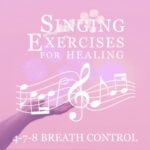
1. The 4-7-8 Breathing Technique
• Inhale quietly through your nose for a count of 4.
• Hold your breath for a count of 7.
• Exhale completely through your mouth for a count of 8, making a soft “whooshing” sound.
• Repeat for four breaths, focusing on a smooth, controlled release of air.

Slow Hissing Exhalations
• Take a deep breath in, filling your lungs completely.
• As you exhale, create a soft “hiss” sound by releasing the air slowly through partially closed lips.
• Try to maintain the “hiss” for as long as possible, focusing on controlled, even airflow.
• Repeat several times, aiming to extend the duration of the exhalation each time.

Breath Holding with Gradual Release
• Inhale deeply, then hold your breath for a few seconds.
• Start exhaling slowly, releasing just a small amount of air at a time, as if deflating a balloon.
• Try to control the release of air to make it last as long as possible.
• Repeat the exercise several times, focusing on gentle, controlled breath release.

The “Sigh of Relief” Exercise
• Take a deep breath and exhale with an audible sigh, allowing your voice to gently fall as you release tension.
• Repeat this, focusing on letting go of any tightness in your body as you “sigh out” your breath.
• Imagine that each sigh releases not only physical tension but also any stress or worry.
The “Sigh of Relief” exercise mimics the body’s natural response to stress relief, which often includes a deep sigh. This exercise calms the mind and creates a sense of release.

The Hum and Slide Exercise
• Start with a low hum, then gradually slide up to a higher pitch and back down again.
• Focus on a smooth, gentle transition between pitches, keeping your voice relaxed and steady.
• Repeat this exercise several times, paying attention to the vibrations in your face and chest.

Soft Staccato Sounds
• Take a deep breath and produce a series of soft, staccato (short and detached) sounds on a comfortable pitch, such as “ha-ha-ha.”
• Focus on engaging the diaphragm and keeping each sound light and effortless.
• Repeat on different pitches to add variety and stimulate the voice.

The Gentle Lip Roll
• Take a deep breath and release it through softly closed lips, allowing them to flutter or “roll” with the airflow.
• Add pitch variations to the lip roll, moving up and down your vocal range.
• Focus on steady, even airflow and keep your lips relaxed.
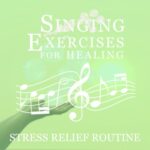
Sample Daily Singing Practice for Stress Relief:
1. Begin with Diaphragmatic Breathing (5 Minutes)
• Start your practice with diaphragmatic breathing to centre yourself and your mind.
2. Move into Vocal Warm-Ups (5–10 Minutes)
• Begin with humming and lip rolls to gently engage the voice.
• Use the hum and slide exercise to release tension and prepare your voice for singing.
3. Focus on Breath Control Exercises (5 Minutes)
• Practice hissing exhalations or breath holding with gradual release to build control and focus.
4. Engage in Vocal Exercises (10–15 Minutes)
• Choose relaxing exercises like the “Sigh of Relief” or soft staccato sounds to promote relaxation and flow.
• Experiment with different pitches and tempos to explore your range and build confidence.
5. End with Body Scanning and Relaxation (5 Minutes)
• Finish by scanning your body for any remaining tension, focusing on a calm, relaxed state.
• Use visualisation or gentle humming to conclude your practice, bringing awareness to your breath and voice.

1.1 Breathing and Warm-Up Exercises to Awaken the Body
Begin with a few minutes of breathing exercises and gentle vocal warm-ups to gradually wake up your body and voice.
Exercises:
• Diaphragmatic Breathing: Sit or stand comfortably, place your hands on your abdomen, and take deep breaths in and out. Focus on expanding your abdomen as you inhale and contracting it as you exhale. Repeat for 2–3 minutes.
• Morning Humming: Start with gentle humming to activate your vocal cords and create relaxing vibrations. Hum softly, focusing on resonance in your face and chest. This will warm up your voice and help you start the day with calm energy.
1.2 Energising Vocal Exercises
Once your voice is warmed up, proceed with exercises that energise and awaken the vocal cords. The following exercises help increase oxygen flow, focus the mind, and provide a gentle “vocal stretch.”
Exercises:
• Lip Trills: Take a deep breath, close your lips loosely, and exhale to create a buzzing sound. Practice sliding up and down through your vocal range. Lip trills improve breath control and engage the diaphragm, providing an invigorating start.
• Sirens: Start on a low pitch and slide up to your highest comfortable note, then back down. This exercise energises the voice, increases vocal flexibility, and promotes mental alertness.
• Five-Note Scales: Sing scales on a neutral syllable, like “la” or “ma.” Begin with lower notes and gradually move up the scale, staying within a comfortable range. This exercise helps you feel more grounded and connected to your voice.
1.3 Positive Affirmation Singing
To conclude your morning routine, practice singing positive affirmations. Choose affirmations that resonate with you and create a simple melody, or sing them to a familiar tune.
Examples of Affirmations:
• “Today, I am calm, focused, and strong.”
• “I embrace today with joy and confidence.”
• “I am energised and ready to shine.”

2.1 Breathing Exercises to Re-Centre and Release Tension
Midday breathing exercises focus on releasing any accumulated tension and refreshing the mind.
Exercises:
• Box Breathing: Inhale for a count of 4, hold for 4, exhale for 4, and hold again for 4. Repeat for several cycles. This exercise resets your breathing, calms the mind, and helps you regain focus.
• Alternate Nostril Breathing: Close one nostril, inhale through the other, then switch. This exercise balances the body’s energy and relieves mental fatigue.
2.2 Grounding Vocal Exercises
The following exercises are short but effective for grounding yourself, re-centring, and reducing midday stress.
Exercises:
• Soft Humming: Hum along to a relaxing tune or create a simple melody. Focus on the vibrations and allow yourself to feel grounded. Humming helps release tension in the jaw and neck, providing a mental reset.
• Vocal Slides: Start on a comfortable note, slide up to a higher pitch, and back down. This exercise stretches the vocal cords and relaxes the mind, helping you shake off mental fatigue.
• Staccato Syllables: Take a deep breath and practice singing short, detached syllables, such as “ha-ha-ha” or “la-la-la.” This exercise energises the voice and mind, helping you return to work or with renewed focus.
2.3 Singing for Emotional Release
If you’re feeling stressed, try singing a favourite song or mantra that brings comfort or positivity. Singing a song that resonates with your current emotions can be a powerful release.
Examples of Midday Singing:
• Choose a soothing song with a positive message, like “Let It Be” by The Beatles, and sing along to release stress.
• If you prefer, sing a simple melody on neutral syllables like “na-na-na” to focus on the feeling of vocalising without specific words.

Evening Routine: Singing to Calm and Unwind
In the evening, singing can help transition from a busy day to a restful night. Evening routines focus on calming the mind, releasing any remaining tension, and promoting relaxation. The exercises in this routine prepare your body for restful sleep and help you let go of the day’s stress.
3.1 Relaxing Breathing Exercises to Unwind
Evening breathing exercises should focus on slowing down and relaxing the nervous system to promote rest.
Exercises:
• 4-7-8 Breathing: Inhale for 4 counts, hold for 7, and exhale slowly for 8 counts. Repeat for a few cycles, allowing your body to relax deeply.
• Extended Exhalation: Inhale for 4 counts and exhale for 6 or 8 counts, allowing each breath to be longer and slower than the last. This promotes a state of calmness and prepares the body for relaxation.
3.2 Gentle Vocal Warm-Downs
Winding down your voice helps release any residual tension and prepares you for a peaceful evening.
Exercises:
• Gentle Humming: Hum softly on a low pitch, allowing your body to relax as you focus on the soothing vibrations. This exercise releases tension and calms the mind.
• Descending Sirens: Begin on a comfortable high note and slide downward to your lowest pitch. This gentle, descending slide mirrors the natural winding down of the day, promoting relaxation.
• Soft “Ooh” or “Ahh” Sounds: Sing soft, sustained “ooh” or “ahh” sounds on a single pitch, allowing your voice to resonate in a relaxed, gentle manner. This creates a feeling of warmth and calm.
3.3 Singing a Calming Lullaby or Mantra
Conclude your evening routine by singing a calming song or mantra. This can be a lullaby, a familiar hymn, or a soothing chant. The repetitive nature of a lullaby or mantra induces a meditative state, promoting relaxation and preparing your body and mind for sleep.
Examples of Evening Songs:
• Lullabies: Sing a simple lullaby like “Twinkle, Twinkle, Little Star” or “Somewhere Over the Rainbow.” Lullabies have a naturally calming rhythm and are excellent for winding down.
• Soothing Mantras: Try singing a mantra or simple phrase, such as “I am peaceful” or “I am safe.” Repeat it softly on a gentle melody to calm the mind.

Day Morning Routine (energising) Midday Routine (centring) Evening Routine (calming)
Mon Diaphragmatic Breathing, Sirens, Affirmation Singing Box Breathing, Humming Gentle Humming, Lullaby Singing
Tue Lip Trills, Five-Note Scales, Positive Song Soft Humming, Vocal Slides Descending Sirens, Mantra Singing
Wed Diaphragmatic Breathing, Lip Trills, Affirmation Alternate Nostril Breathing, Staccato Syllables 4-7-8 Breathing, Lullaby Singing
Thurs Morning Humming, Vocal Slides, Affirmation Singing Soft Humming, Grounding Exercises Visualisation with calming Song
Fri Sirens, Positive Song, Affirmation Singing Box Breathing, Gentle Humming Extended Exhalation, Soothing Mantra
Sat Lip Trills, Energetic Song, Positive Reflection Midday Staccato Syllables Descending Sirens, Gentle Humming
Sun Diaphragmatic Breathing, Calm Song, Reflection Alternate Nostril Breathing Body Scanning with Soft Humming

Diaphragmatic Breathing with Humming
Objective: To ground the body, slow down the breath, and create a sense of calm.
Instructions:
1. Find a comfortable seated or standing position. Place one hand on your abdomen to feel the movement of your diaphragm.
2. Take a deep breath in through your nose, allowing your belly to expand.
3. Exhale slowly through your mouth with a soft “hmm” sound, feeling the vibrations in your chest.
4. Repeat this for 5–10 breaths, focusing on a smooth, slow exhalation.

Gentle Vocal Slides on “Ah”
Objective: To release tension and create a sense of flow in the body and mind.
Instructions:
1. Begin on a comfortable pitch, singing “ah” softly.
2. Slide your voice down a few notes, creating a gentle descent in pitch.
3. Repeat this slide for a few breaths, focusing on letting go of any tension with each “ah.”

Singing Affirmations
Objective: To shift focus from anxious thoughts to positive affirmations.
Instructions:
1. Choose a simple affirmation that resonates with you, such as “I am safe” or “I am calm.”
2. Sing the affirmation slowly and gently, repeating it to a simple melody or chant.
3. Let each word carry meaning, focusing on the intention behind the affirmation.

Morning Wake-Up Song
Objective: To introduce positive energy and lift the mood in the morning.
Instructions:
1. Choose an upbeat, simple melody or a song that feels uplifting to you.
2. Start with soft humming on the melody, then gradually move to singing the lyrics.
3. Let yourself smile as you sing, focusing on the positive message or rhythm of the song.

Vowel Sounds to Open the Heart
Objective: To create openness and release any sense of heaviness in the chest.
Instructions:
1. Take a deep breath, then sing a long “ah” sound on a comfortable note.
2. As you sing, imagine your chest opening and releasing any tension or sadness.
3. Move to other vowel sounds, such as “ooh” and “ee,” experimenting with different pitches.

Group Singing (If Possible)
Objective: To experience social connection and reduce feelings of loneliness.
Instructions:
1. If you have access to a choir, singing group, or online singing class, join in and sing together with others.
2. Focus on the experience of sharing your voice with the group, feeling the energy and connection.

Energising Lip Trills
Objective: To wake up the voice and body, increasing energy and focus.
Instructions:
1. Take a deep breath and exhale with a lip trill, creating a gentle buzzing sound.
2. Practice lip trills on ascending and descending scales, covering a range of pitches.
3. Focus on steady breath control and a relaxed face.

Staccato Syllables on “Ha”
Objective: To build mental alertness and physical engagement.
Instructions:
1. Take a deep breath and sing a series of short “ha-ha-ha” sounds on a single pitch.
2. Keep the sounds light and rhythmic, focusing on quick, sharp exhalations.
3. Repeat this exercise on different pitches to create variety.

“Good Morning” Song
Objective: To awaken the mind and body with an uplifting melody.
Instructions:
1. Choose a simple, cheerful melody or create one with words like “Good morning to me, I am ready and free.”
2. Sing the melody with a smile, focusing on its positive, energetic qualities.
3. Repeat a few times, letting the energy
build with each repetition.
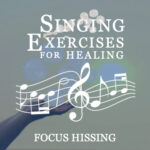
Breath Control with Hissing Exhalations
Objective: To increase focus and build control over breath.
Instructions:
1. Take a deep breath, filling your lungs completely.
2. As you exhale, create a hissing sound, controlling the release of air.
3. Focus on maintaining a steady, even sound for as long as possible, gradually increasing the duration of each exhalation.
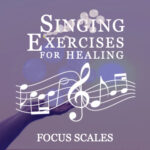
Singing Scales for Focused Attention
Objective: To develop mental clarity and concentration through vocal range exercises.
Instructions:
1. Choose a simple scale, like a five-note or octave scale.
2. Sing the scale on a single vowel, such as “ee” or “ah.”
3. Pay close attention to each note, focusing on pitch accuracy, tone, and consistency.

Rhythm and Clapping Exercise
Objective: To enhance mental clarity and focus by synchronising singing with rhythm.
Instructions:
1. Choose a simple song or melody and clap along with the beat.
2. Try to vary the rhythm of your clapping, matching it to the melody in different ways (e.g., double-time or half-time).
3. Maintain focus on coordinating your singing and clapping.
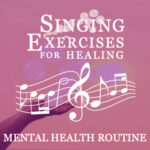
Full Routine Example (Approximately 20-30 Minutes)
1. Diaphragmatic Breathing with Humming (3 Minutes)
• Begin with breathing exercises to centre yourself, then hum softly to activate your vocal cords.
2. Lip Trills and Vocal Slides (5 Minutes)
• Practice lip trills to engage your breath and increase energy, followed by gentle vocal slides to release tension.
3. Affirmation Singing for Positivity (5 Minutes)
• Choose a positive affirmation, such as “I am calm and centred” or “I embrace today with joy.”
• Sing the affirmation slowly and with intention, repeating it a few times to a simple melody.
• Focus on letting the positive message resonate within you, helping to uplift your mood and foster emotional stability.
4. Singing Scales for Focused Attention (5 Minutes)
• Pick a comfortable scale, like a five-note or octave scale, and sing it on a single vowel, such as “ee” or “ah.”
• Pay close attention to each note, maintaining steady breath control and focusing on pitch accuracy and tone.
• This exercise enhances concentration and mental clarity, helping you build focus.
5. Staccato Syllables on “Ha” for Alertness (3 Minutes)
• Take a deep breath and sing short, detached “ha-ha-ha” sounds on a single pitch.
• Focus on rhythmic, quick exhalations with each “ha,” keeping your voice light and energetic.
• Repeat on different pitches to create variety and increase alertness, providing a natural energy boost.
6. Gentle Humming to Wind Down (3 Minutes)
• Conclude the session by softly humming a relaxing melody or a favourite tune.
• Focus on the vibrations in your chest and face, allowing any remaining tension to release.
• This gentle hum serves as a vocal “cool down,” bringing calm and closure to the routine.
Total Duration: Approximately 20–30 minutes

To come!
“Singing allows the soul to speak from the heart without the limits of words.”.

— Anonymous
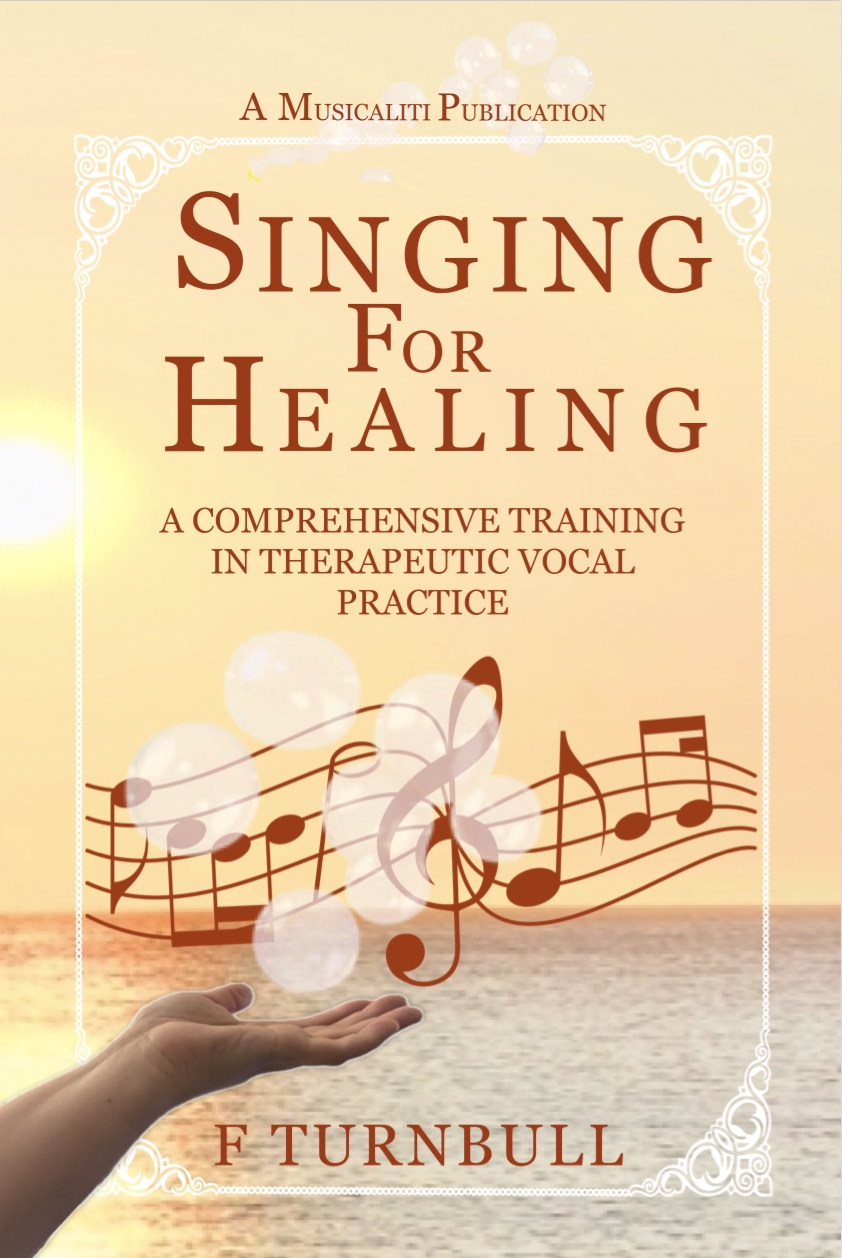
Upcoming Book
This is the latest book that is currently in process, sign up to our newsletter for more updates!
“To sing is to breathe and to breathe is to live mindfully. Through singing, we find ourselves truly present, one breath at a time.”

— Anonymous
Designer
